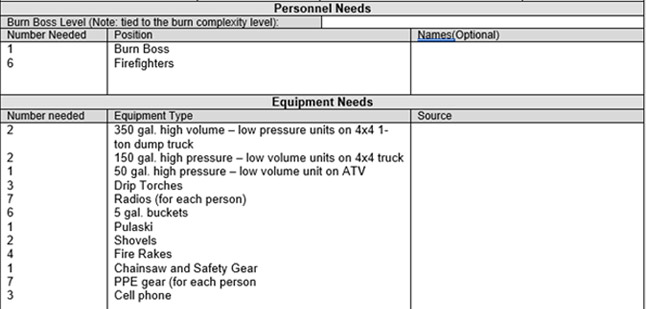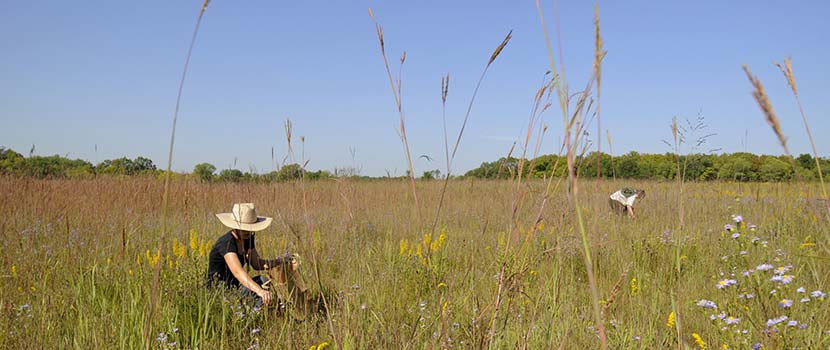
Fire used to be a natural occurrence in many ecosystems, including prairies, savannas and oak woodlands. Because of this, many plants and animals became dependent on or adapted to fires. American Indians also regularly used fire for many reasons, including agricultural and hunting purposes.
As Europeans settled the area in the 1800s, they suppressed prairie and woodland fires. Removing fire from the ecosystem, however can harm these fire-dependent plants and endanger their existence. Today, Three Rivers and others use prescribed fires to help manage and restore these important ecosystems.
Use of fire in habitat management requires careful planning that begins long before a fire is ever lit. Read on to learn what goes into preparing for a prescribed burn at Three Rivers.
Step 1: Selecting and Preparing Burn Sites
Before anyone thinks about lighting a match or walking with a drip torch, a lot of work has to take place. At Three Rivers, we start planning burns six to nine months before the fire. Our first step is to select the prairie and woodland units we want to burn the following spring. The units are mapped showing fire breaks, obstructions and adjacent units.
Fire breaks are then mowed around the planned burn to keep the fire contained. Many times, the fire break is a trail, road or lake edge so mowing is not needed. In areas where we do need to create a break, we mow a 10-foot wide trail to eliminate the tall grass. This allows the grass in the fire break to green up early in the spring. Short green grass burns very slowly, so the fire will not cross the break.

Step 2: Creating A Burn Plan
The next step is to complete a three-page burn plan. This includes information on the size of the unit, the type and size of the fuel (grass or brush), the location of the fire breaks, and the adjacent land use. We also include the acceptable wind direction and speed, humidity levels and soil moisture, as well as a list of the fire equipment and crew members that will be at the unit during the burn. With all the different equipment needed to conduct a burn, this can look like a long shopping list.

The plan also includes sections on smoke management, contingency, safety and medical emergencies as well as a list of emergency and burn activity contacts. There can be as many as 10 phone numbers on the list. The burn boss normally calls four or five of the contacts before each burn. View a sample burn plan.
Step 3: Submitting the Plan for Permits
The completed burn plan is then sent to the Minnesota Department of Natural Resources and local fire department for permits. Once the plans and permits are in place, which sometimes takes up to three weeks, we wait for spring and ideal conditions.
Step 4: Waiting for the Right Conditions
There are many days that start out looking promising, but then the wind speed increases or the wind direction changes leaving the burn crew to wait for another day. High wind speeds can make a fire difficult to control, and changes in wind direction can cause the smoke to blow across busy roads, into neighborhoods or around large buildings.
When conditions are right, we can conduct a burn.

At Three Rivers, we have been safely conducting controlled burns for over 40 years. We burn our prairies every four to five years and woodlands every six to eight years. To learn what happens during a burn and what benefits a burn provides prairie ecosystems, read our previous post on protecting prairies with fire.
About the Author

John Moriarty is the Senior Manager of Wildlife at Three Rivers Park District and has been with the Park District for 15 years. He has been involved in many of the wildlife restoration efforts and initiated the snake and butterfly efforts. John has led several projects to increase prairie habitat in the Park District. John likes exploring natural areas and looking for all types of plants and animals, but especially turtles.
Related Blog Posts
Prairie Burns: Protecting Precious Habitat with Fire
By: Erin Korsmo
Three Rivers conducts controlled burns at its prairies each spring. Learn what goes into burning a prairie and why fire is so important to preserving this special habitat.
What's in a Seed? Why Prairie Seed Collection Matters
By: Erin Korsmo
Prairies are the most threatened habitat in Minnesota. Some species that depend on prairies are now on endangered and threatened species lists. Read on to learn about the important role volunteer seed collectors play in saving the prairies and the creatures that inhabit them.
Crow-Hassan Prairie: 50 Years in the Making
By: John Moriarty
This year, Three Rivers is celebrating 50 years of prairie restoration at Crow-Hassan Park Reserve. Learn how it all began and how managing and restoring prairies has evolved since 1969.



